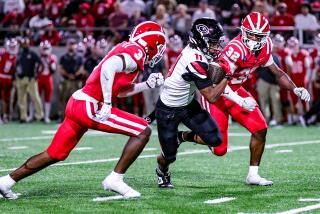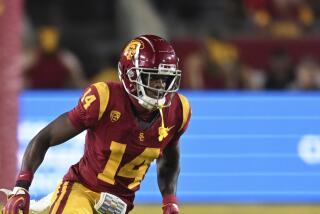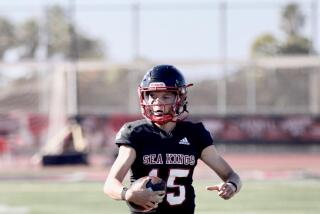Red/Black Game to Be Studied Intensely
SAN DIEGO — In San Diego State’s Red/Black intrasquad football game tonight, Dan McGwire could throw for 400 yards. Patrick Rowe could catch a dozen balls. John Wesselman could break up five passes, intercept two and assist on 15 tackles.
They have all demonstrated this spring the capabilities to do so. But the leading item on Coach Al Luginbill’s mind, and the first words out of his mouth probably would be, “As a team, I thought our intensity level was...”
Intensity level; this is how Luginbill judges his football team’s performance in the spring.
In the fall, it will be victories and defeats. But in the spring, it is intensity level.
Using Luginbill’s barometer, the Aztecs are 3-1 in scrimmages so far this spring. After tonight, when SDSU ends its spring drills with the Red/Black game at 7 in Aztec Bowl, the Aztecs could be 4-1, as it will be the final opportunity for contact until the team resumes practice in August.
Not bad, but not perfect either, which is what Luginbill was striving for in his first spring as a Division I head football coach.
Give SDSU a B+. Make them an eight on a scale of 10. Or, as one school official noted last week, “This football team has come a long way. Of course, it had a long way to come.”
SDSU was 3-8, 3-5 in the Western Athletic Conference, last season and 5-7, 4-4 in 1987 under former coach Denny Stolz. It is now Luginbill’s task to turn the fortunes of a program gone sour into what he hopes will become “The Miami of the West Coast.”
As the self-proclaimed “attitude” coach, he has chosen to take the first steps on that road by emphasizing, and re-emphasizing, one thing--the intensity level.
“I’ve never seen a football team play efficiently without playing with intensity on every down,” Luginbill said.
After five weeks, that attitude is beginning to embed in the players’ minds. Asked to describe this year’s spring drills, defensive end Pio Sagapolutele said, “More hitting. More discipline. More intensity. We’re on a different level than last year.”
Said Wesselman, a senior safety, “Compared to springs in the past, we’re a lot more intense. It’s like game week every day out there.”
So what has that intensity wrought? “Competitiveness,” says Wesselman. “It was never ever like this last year. A lot of things have changed.”
Whereas there have been some changes--expected when any new coach takes over--some old trends continue. The offensive skill positions and defensive front are the strengths of the team.
At quarterback, Dan McGwire, a 6-foot-8 transfer from Iowa, has proven he can throw the ball as proficiently as his brother, Oakland A’s Mark McGwire, hits one. McGwire and 1988 starter Brad Platt have competed for the starting job all spring, but it has become increasing clear that McGwire will be calling the signals Sept. 2 when the Aztecs open the season at the Air Force Academy.
And McGwire will have some talented receivers on the other end of his throws. Rowe, a junior, has been the most productive this spring, having caught at least one touchdown pass of 50 yards or more in each scrimmage.
In the Aztecs three-receiver offense, Rowe is expected to join Monty Gilbreath, who had arthroscopic knee surgery last week, and Robert Claiborne, who missed most of the spring with a pulled hamstring, in the starting lineup. Dennis Arey, Jimmy Raye and Tony Nettles have been impressive too, making this the deepest position on the team.
Three running backs--Darrin Wagner, Ron Slack and Tommy Booker--have competed for the tailback spot. Wagner, who left for Nebraska in January but returned to the Aztecs days later, appears to be the favorite for the starting job, but Slack has performed well
The offensive line has shown promise but remains a question mark primarily because of injuries and new personnel. Center Steve Blyth ruptured a tendon below his kneecap. The Aztces are hoping to have him back by the fall, but this is the same type of injury that Pedro Guerrero suffered with the Dodgers in 1986. Guerrero missed five months, and he was not expected to take on opposing nose tackles. SDSU’s season opens in less than four months.
Of the returning starters at guard, Nick Subis missed all of spring following eye surgery and Roman Fortin has been slowed by a knee bruise. Bonner Montler has moved from linebacker to center and is competing with Zae Perrin. Last season’s fullback, Jim Jennings, has been moved to guard.
Derek Sang, who did not see action last season, joins returning starter Damon Baldwin on the first team offensive line.
Luginbill says the biggest question mark is at tight end, where Mitch Burton, Jim Hanawalt, Ray Rowe and Mike Misch have been after the starting spot.
The kicking positions will probably be decided in the fall, too. Although Joe Santos returns at punter, he is also playing defensive back. Tom Wurth will battle with Patrick Henry High’s Andy Trakas for placekicking duties.
The defensive line, with Bob Graff, Jason Swaney, Pio Sagapolutele and Eric Duncan on the first team , is the deepest position and the strength of the defense.
The linebacking corps has been Luginbill’s biggest concern on the defense. Tracey Moa and Sai Niu are the starters, but it thins out after that.
The Aztecs remain questionable in the secondary, too. Returning starter Clark Moses has missed the past two weeks with a shoulder separation. Larry Maxey, moved from running back, has been working out with the first team, as have Kevin Drayton, Gary Taylor, Morey Paul and Johnny Walker.
And then there is Wesselman. He was a starter at outside linebacker last year and was the special team’s player of the year but is being called a nickel back this season.
Wesselman will play up like a linebacker in running or blitzing situations and roam the secondary like a free safety on passing downs. “It depends on the style of team we’re playing,” said Barry Lamb, SDSU’s defensive coordinator. “But he’ll be on the field somewhere. He’s a football player.”
More importantly, Wesselman is the kind of player Luginbill wants. He plays with intensity.
More to Read
Go beyond the scoreboard
Get the latest on L.A.'s teams in the daily Sports Report newsletter.
You may occasionally receive promotional content from the Los Angeles Times.










